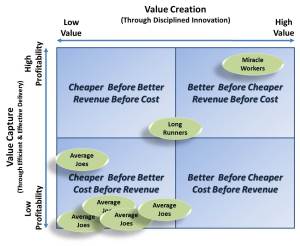Failure to execute is a leading reason why organizations don’t gain the full benefit of their innovation initiative investments. Day-to-day business pressures quickly overcome all the good work creating an innovative idea when it comes time to execute. Something we have previously called the innovation-delivery paradox. An ongoing challenge is how can firms execute on innovation better while still delivering on the day-to-day?
The four disciplines of execution or 4DX method developed by Chris McChesney, Sean Covey, and Jim Huling provides a solid methodology to solve this challenge.
4DX Method
The 4DX method is based on these four disciplines:
- Discipline 1: Focus on the wildly important
- Discipline 2: Act on the lead measures
- Discipline 3: Keep a compelling scoreboard
- Discipline 4: Create a cadence of accountability
Why The 4DX Method Is Particularly Well Suited To Execute on Innovation
Focus. The 4DX method helps the innovation team bring focus to the main business goal of the innovation and drive cross organizational collaboration for innovation that requires change to the firm’s business model.
Results Oriented. Most business executives are well aware that key performance metrics are usually lag measures and organizations have difficulty linking actions to lag measure results. Lead measures that are often less than obvious enable team members to link their efforts to lag measure results. The 4DX method provides a systematic method to identify and optimize lead measures unique to the innovation.
Allows Experimentation. This is perhaps the most critical reason. Experimentation, failure, and learning are central to innovation. The regular team session based on commitment, accountability, and problem solving supports fast and responsive adaption as the innovation idea is implemented. No innovation initiative can foresee all the challenges in bringing an innovation to market. The 4DX method enables teams to break down the challenges and try different approaches to learn faster.
Enables Change. All innovation requires some degree of change. Change in behaviour. Change in business model. Change in procedures. Failure to execute on innovation is closely tied to failure to change. The 4DX method provides a positive framework to help teams through the change necessary to implement innovation.
Facilitates Engagement. Innovation is a team sport. Everyone in the firm has to contribute to achieve the full benefit from innovation. The 4DX method facilitates engagement by clarifying how each team member can contribute to success as well as how their efforts achieves results.
Builds Momentum to Success. The regular cadence of the 4DX method along with flexibility to support experimentation helps to build momentum where team members get faster feedback and short term success. Through the medium term repeated application to follow-on innovation enables the culture of innovation execution to be strengthened.
Moving Forward
Adopting the 4DX method to overcome the challenge of innovating while delivering the day-to-day requires effort, commitment, and resilience. Alopex can help you through this process and strengthen your culture of innovation execution.



